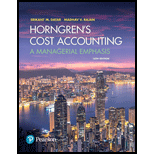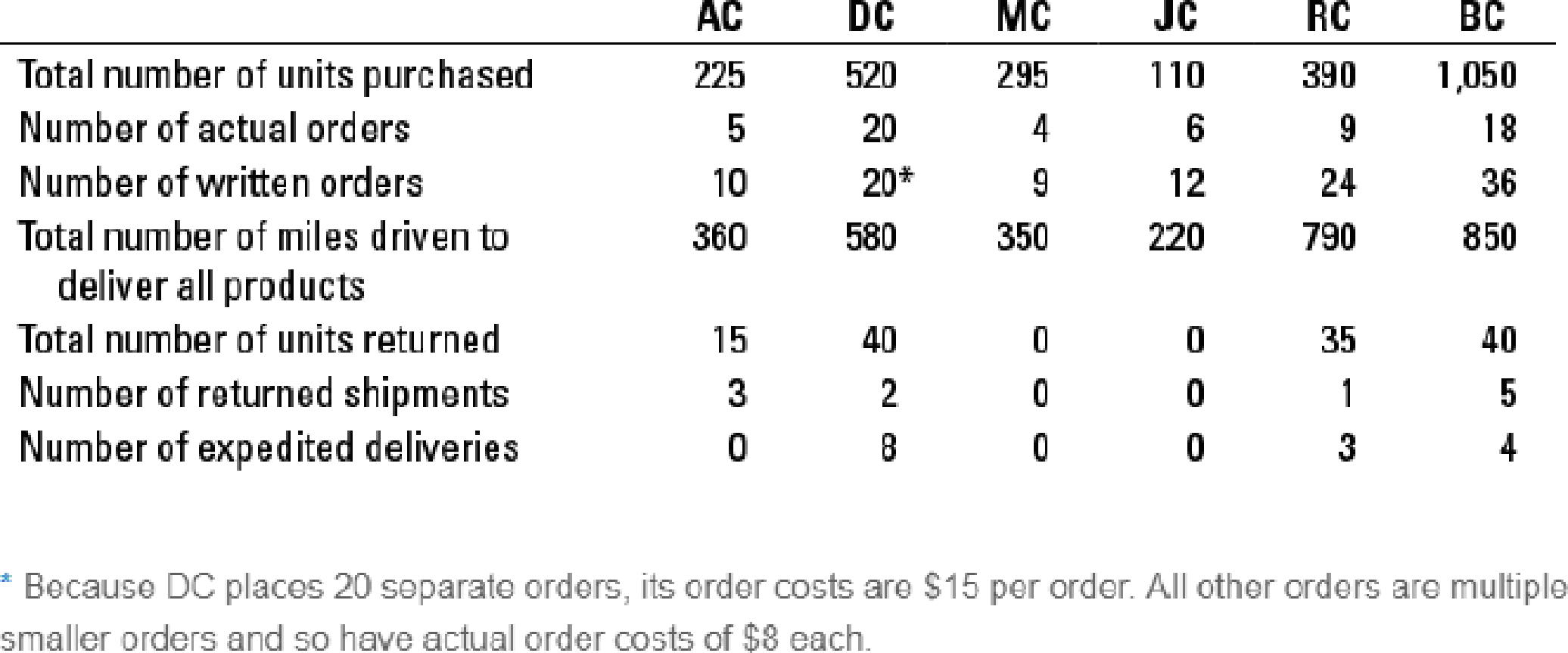
Concept explainers
Customer profitability and ethics. KC Corporation manufactures an air-freshening device called GoodAir, which it sells to six merchandising firms. The list price of a GoodAir is $30, and the full
KC Corporation makes products based on anticipated demand. KC carries an inventory of GoodAir, so rush orders do not result in any extra manufacturing costs over and above the $18 per unit. KC ships finished product to the customer at no additional charge for either regular or expedited delivery. KC incurs significantly higher costs for expedited deliveries than for regular deliveries. Customers occasionally return shipments to KC, and the company subtracts these returns from gross revenue. The customers are not charged a restocking fee for returns.
Budgeted (expected) customer-level cost driver rates are:
| Order taking (excluding sales commission) | $15 per order |
| Product handling | $1 per unit |
| Delivery | $1.20 per mile driven |
| Expedited (rush) delivery | $175 per shipment |
| Restocking | $50 per returned shipment |
| Visits to customers | $125 per customer |
Because salespeople are paid $10 per order, they often break up large orders into multiple smaller orders. This practice reduces the actual order-taking cost by $7 per smaller order (from $15 per order to $8 per order) because the smaller orders are all written at the same time. This lower cost rate is not included in budgeted rates because salespeople create smaller orders without telling management or the accounting department. All other actual costs are the same as budgeted costs.
Information about KC’s clients follows:

- 1. Classify each of the customer-level operating costs as a customer output unit–level, customer batch-level, or customer-sustaining cost.
Required
- 2. Using the preceding information, calculate the expected customer-level operating income for the six customers of KC Corporation. Use the number of written orders at $15 each to calculate expected order costs.
- 3. Recalculate the customer-level operating income using the number of written orders but at their actual $8 cost per order instead of $15 (except for DC, whose actual cost is $15 per order). How will KC Corporation evaluate customer-level operating cost performance this period?
- 4. Recalculate the customer-level operating income if salespeople had not broken up actual orders into multiple smaller orders. Don’t forget to also adjust sales commissions.
- 5. How is the behavior of the salespeople affecting the profit of KC Corporation? Is their behavior ethical? What could KC Corporation do to change the behavior of the salespeople?
Want to see the full answer?
Check out a sample textbook solution
Chapter 14 Solutions
REVEL for Horngren's Cost Accounting: A Managerial Emphasis -- Access Card (16th Edition) (What's New in Accounting)
- I need a expert not AI Step Amount Category Inventory 1. Beginning Balance, January 1 28,000 Beginning Balance Raw Materials 2. (+) Purchases (RM Purchases) 220,000 Addition Raw Materials 3. (-) Ending Balance 20,000 Ending Balance Raw Materials 4. = Transferred Out (RM used) (228,000) Transferred Out Raw Materials 5. (+) Direct Labor (152,000) Transferred Out Direct Labor 6. (+) Fixed Overhead 300,000 Addition Overhead 7. (+) Variable Overhead - Addition Overhead 8. = Total Factory Overhead (390,000) Transferred Out Overhead 9. Beginning Balance, January 1 40,000 Beginning Balance WIP 10. (+) Additions (RM used) 228,000 Addition WIP 11. (+) Additions (DL used) 152,000 Addition WIP 12. (+) Additions (OH used) 390,000 Addition WIP 13. (-) Ending Balance, December 31 55,000 Ending Balance WIP 14. = Transferred Out (COGM) (755,000)…arrow_forwardStep Amount Category Inventory 1. Beginning Balance, January 1 28,000 Beginning Balance Raw Materials 2. (+) Purchases (RM Purchases) 220,000 Addition Raw Materials 3. (-) Ending Balance 20,000 Ending Balance Raw Materials 4. = Transferred Out (RM used) (228,000) Transferred Out Raw Materials 5. (+) Direct Labor (152,000) Transferred Out Direct Labor 6. (+) Fixed Overhead 300,000 Addition Overhead 7. (+) Variable Overhead - Addition Overhead 8. = Total Factory Overhead (390,000) Transferred Out Overhead 9. Beginning Balance, January 1 40,000 Beginning Balance WIP 10. (+) Additions (RM used) 228,000 Addition WIP 11. (+) Additions (DL used) 152,000 Addition WIP 12. (+) Additions (OH used) 390,000 Addition WIP 13. (-) Ending Balance, December 31 55,000 Ending Balance WIP 14. = Transferred Out (COGM) (755,000) Transferred Out WIP 15.…arrow_forwardIntroduce yourself to your peers by sharing something unique about your background. Explain how you expect this course will help you move forward in your current or future career.arrow_forward
- Step Amount Category Inventory 1. Beginning Balance, January 1 28,000 Beginning Balance Raw Materials 2. (+) Purchases (RM Purchases) 220,000 Addition Raw Materials 3. (-) Ending Balance 20,000 Ending Balance Raw Materials 4. = Transferred Out (RM used) (228,000) Transferred Out Raw Materials 5. (+) Direct Labor (152,000) Transferred Out Direct Labor 6. (+) Fixed Overhead 300,000 Addition Overhead 7. (+) Variable Overhead - Addition Overhead 8. = Total Factory Overhead (390,000) Transferred Out Overhead 9. Beginning Balance, January 1 40,000 Beginning Balance WIP 10. (+) Additions (RM used) 228,000 Addition WIP 11. (+) Additions (DL used) 152,000 Addition WIP 12. (+) Additions (OH used) 390,000 Addition WIP 13. (-) Ending Balance, December 31 55,000 Ending Balance WIP 14. = Transferred Out (COGM) (755,000) Transferred Out WIP 15.…arrow_forward1. Beginning Balance, January 1 28,000 Beginning Balance Raw Materials 2. (+) Purchases (RM Purchases) 220,000 Addition Raw Materials 3. (-) Ending Balance 20,000 Ending Balance Raw Materials 4. = Transferred Out (RM used) (228,000) Transferred Out Raw Materials 5. (+) Direct Labor (152,000) Transferred Out Direct Labor 6. (+) Fixed Overhead 300,000 Addition Overhead 7. (+) Variable Overhead ? Addition Overhead 8. = Total Factory Overhead (390,000) Transferred Out Overhead 9. Beginning Balance, January 1 40,000 Beginning Balance WIP 10. (+) Additions (RM used) 228,000 Addition WIP 11. (+) Additions (DL used) 152,000 Addition WIP 12. (+) Additions (OH used) 390,000 Addition WIP 13. (-) Ending Balance, December 31 55,000 Ending Balance WIP 14. = Transferred Out (COGM) (755,000) Transferred Out WIP 15. Beginning Balance, January 1…arrow_forwardPalladium, Incorporated recently lost a portion of its records in an office fire. The following information was salvaged from the accounting records. Cost of Goods Sold $ 67,000 Work-in-Process Inventory, Beginning 11,300 Work-in-Process Inventory, Ending 9,400 Selling and Administrative Expense 16,000 Finished Goods Inventory, Ending 16,100 Finished Goods Inventory, Beginning ?question mark Direct Materials Used ?question mark Factory Overhead Applied 12,400 Operating Income 14,220 Direct Materials Inventory, Beginning 11,180 Direct Materials Inventory, Ending 6,140 Cost of Goods Manufactured 61,880 Direct labor cost incurred during the period amounted to 1.5 times the factory overhead. The Chief Financial Officer of Palladium, Incorporated has asked you to recalculate the following accounts and to report to him by the end of the day. What is the amount in the finished goods inventory at the beginning of the year?arrow_forward
- Which of the following statements is incorrect regarding manufacturing overhead? Multiple Choice Manufacturing overhead includes both fixed and variable costs. Manufacturing overhead is an indirect cost to units or products. Actual overhead costs are used in the cost accounting process. Actual overhead costs tend to remain relatively constant over various output levels.arrow_forwardPalladium, Incorporated recently lost a portion of its records in an office fire. The following information was salvaged from the accounting records. Cost of Goods Sold $ 72,500 Work-in-Process Inventory, Beginning 13,500 Work-in-Process Inventory, Ending 10,500 Selling and Administrative Expense 18,750 Finished Goods Inventory, Ending 19,125 Finished Goods Inventory, Beginning ?question mark Direct Materials Used ?question mark Factory Overhead Applied 13,500 Operating Income 14,825 Direct Materials Inventory, Beginning 11,675 Direct Materials Inventory, Ending 6,525 Cost of Goods Manufactured 67,050 Direct labor cost incurred during the period amounted to 1.5 times the factory overhead. The Chief Financial Officer of Palladium, Incorporated has asked you to recalculate the following accounts and to report to him by the end of the day. What is the amount of direct materials purchased?arrow_forwardOn December 31, 2022, Akron, Incorporated, purchased 5 percent of Zip Company's common shares on the open market in exchange for $15,650. On December 31, 2023, Akron, Incorporated, acquires an additional 25 percent of Zip Company's outstanding common stock for $93,500. During the next two years, the following information is available for Zip Company: Year Income Dividends Declared Common Stock Fair Value (12/31) 2022 $ 313,000 2023 $ 70,000 $ 7,800 374,000 2024 90,000 15,100 476,000 At December 31, 2023, Zip reports a net book value of $294,000. Akron attributed any excess of its 30 percent share of Zip's fair over book value to its share of Zip's franchise agreements. The franchise agreements had a remaining life of 10 years at December 31, 2023. Required: Assume Akron applies the equity method to its Investment in Zip account: What amount of equity income should Akron report for 2024? On Akron's December 31, 2024, balance sheet, what amount is reported for the…arrow_forward
- Calculate JCI's projected free cash flow; the tax rate is 25%. Enter your answer in millions. For example, an answer of $1.23 million should be entered as 1.23, not 1,230,000. Round your answer to two decimal places. $ ? What is JCI's current intrinsic stock price (the price on 6/30/2021)? What is the projected intrinsic stock price for 6/30/2022? FCF is expected to grow at a constant rate of 5%, and JCI's WACC is 9%. The firm has 800 million shares outstanding. Round your answers to the nearest cent. Intrinsic stock price on 6/30/2021: $ ? Intrinsic stock price on 6/30/2022: $ ? What is the projected intrinsic stock price on 7/1/2022 if JCI distributes the cash as dividends? Round your answer to the nearest cent. $ ? What is the projected intrinsic stock price on 7/1/2022 if JCI distributes the cash through stock repurchases? Round your answer to the nearest cent. $ ? How many shares will remain outstanding after the repurchase? Enter your answer in millions. For example, an…arrow_forwardkindly help me with accounting questionarrow_forwardQuick answer of this accounting questionsarrow_forward
 Principles of Cost AccountingAccountingISBN:9781305087408Author:Edward J. Vanderbeck, Maria R. MitchellPublisher:Cengage Learning
Principles of Cost AccountingAccountingISBN:9781305087408Author:Edward J. Vanderbeck, Maria R. MitchellPublisher:Cengage Learning Cornerstones of Cost Management (Cornerstones Ser...AccountingISBN:9781305970663Author:Don R. Hansen, Maryanne M. MowenPublisher:Cengage LearningPrinciples of Accounting Volume 2AccountingISBN:9781947172609Author:OpenStaxPublisher:OpenStax College
Cornerstones of Cost Management (Cornerstones Ser...AccountingISBN:9781305970663Author:Don R. Hansen, Maryanne M. MowenPublisher:Cengage LearningPrinciples of Accounting Volume 2AccountingISBN:9781947172609Author:OpenStaxPublisher:OpenStax College


